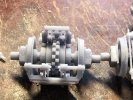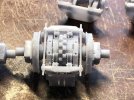I'd like to throw myself on the mercies of the assemvled throng please!
I'm (very) slowly learning my round Fusion 360 as a 3-D design programme, and have been drawing up some "small" items in 4mm (P4) that I'd like to print in resin. Historically, I used Turbocad and always drew at full size and then scaled to suit. I've kept this method of working with Fusion 360, but it throws a tantrum if one tries to scale at 1.76.2 - the decimal place gives an error and the closest I can get is 1.76, which gives an 18" long object a length of 5.941mm instead of 6mm.
1. How do other Fusion 360 users draw and scale? Is there a factor to give 4mm/ft that I'm missing?
2. Am I being pedantic about the error? However, this would translate into an error of 6mm in a 60 foot length.
3. I'm taking it for granted that you wouldn't rely on slicer programme for scaling?
Many thanks in advance for any assistance.
Cheers,
Paul
I'm (very) slowly learning my round Fusion 360 as a 3-D design programme, and have been drawing up some "small" items in 4mm (P4) that I'd like to print in resin. Historically, I used Turbocad and always drew at full size and then scaled to suit. I've kept this method of working with Fusion 360, but it throws a tantrum if one tries to scale at 1.76.2 - the decimal place gives an error and the closest I can get is 1.76, which gives an 18" long object a length of 5.941mm instead of 6mm.
1. How do other Fusion 360 users draw and scale? Is there a factor to give 4mm/ft that I'm missing?
2. Am I being pedantic about the error? However, this would translate into an error of 6mm in a 60 foot length.
3. I'm taking it for granted that you wouldn't rely on slicer programme for scaling?
Many thanks in advance for any assistance.
Cheers,
Paul



